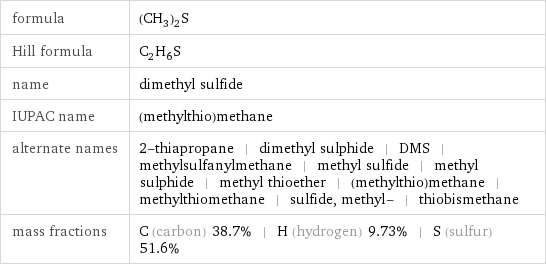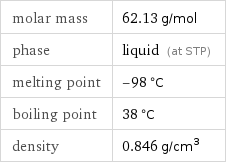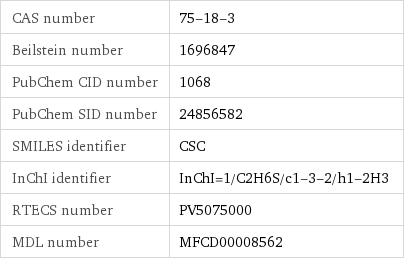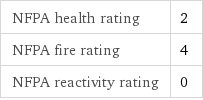Input interpretation

dimethyl sulfide
Chemical names and formulas

formula | (CH_3)_2S Hill formula | C_2H_6S name | dimethyl sulfide IUPAC name | (methylthio)methane alternate names | 2-thiapropane | dimethyl sulphide | DMS | methylsulfanylmethane | methyl sulfide | methyl sulphide | methyl thioether | (methylthio)methane | methylthiomethane | sulfide, methyl- | thiobismethane mass fractions | C (carbon) 38.7% | H (hydrogen) 9.73% | S (sulfur) 51.6%
Lewis structure

Draw the Lewis structure of dimethyl sulfide. Start by drawing the overall structure of the molecule: Count the total valence electrons of the carbon (n_C, val = 4), hydrogen (n_H, val = 1), and sulfur (n_S, val = 6) atoms: 2 n_C, val + 6 n_H, val + n_S, val = 20 Calculate the number of electrons needed to completely fill the valence shells for carbon (n_C, full = 8), hydrogen (n_H, full = 2), and sulfur (n_S, full = 8): 2 n_C, full + 6 n_H, full + n_S, full = 36 Subtracting these two numbers shows that 36 - 20 = 16 bonding electrons are needed. Each bond has two electrons, so the above diagram has all the necessary bonds. There are 8 bonds and hence 16 bonding electrons in the diagram. Lastly, fill in the remaining unbonded electrons on each atom. In total, there remain 20 - 16 = 4 electrons left to draw: Answer: | |
3D structure

3D structure
Basic properties

molar mass | 62.13 g/mol phase | liquid (at STP) melting point | -98 °C boiling point | 38 °C density | 0.846 g/cm^3
Units

Liquid properties (at STP)

density | 0.846 g/cm^3 vapor pressure | 1357 mmHg dynamic viscosity | 2.84×10^-4 Pa s (at 25 °C) surface tension | 0.0265 N/m refractive index | 1.435
Units

Thermodynamic properties

specific heat capacity c_p | gas | 1.193 J/(g K) | liquid | 1.901 J/(g K) molar heat capacity c_p | gas | 74.1 J/(mol K) | liquid | 118.1 J/(mol K) molar heat of vaporization | 27 kJ/mol | specific heat of vaporization | 0.435 kJ/g | molar heat of combustion | 1915 kJ/mol | specific heat of combustion | 30.82 kJ/g | molar heat of fusion | 7.99 kJ/mol | specific heat of fusion | 0.129 kJ/g | critical temperature | 502 K | critical pressure | 5.532 MPa | (at STP)
Chemical identifiers

CAS number | 75-18-3 Beilstein number | 1696847 PubChem CID number | 1068 PubChem SID number | 24856582 SMILES identifier | CSC InChI identifier | InChI=1/C2H6S/c1-3-2/h1-2H3 RTECS number | PV5075000 MDL number | MFCD00008562
NFPA label

NFPA label

NFPA health rating | 2 NFPA fire rating | 4 NFPA reactivity rating | 0
Safety properties

flash point | -36.67 °C autoignition point | 205 °C lower explosive limit | 2.2% (concentration in air) upper explosive limit | 19.7% (concentration in air)

DOT hazard class | 3 DOT numbers | 1164
Toxicity properties

lethal dosage | 535 mg/kg (oral dose for rats) threshold limit value | 10 ppmv

probable lethal dose for man | 600 mL (milliliters) RTECS classes | primary irritant